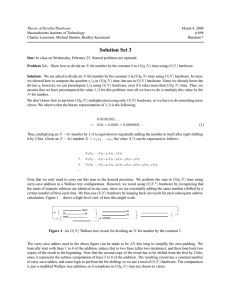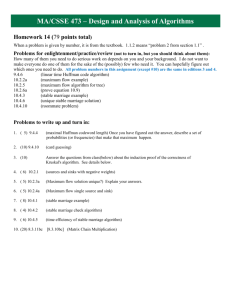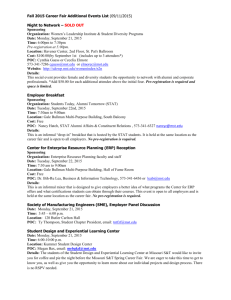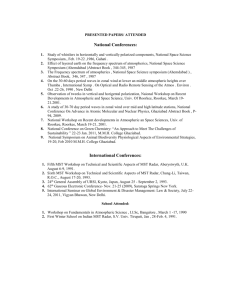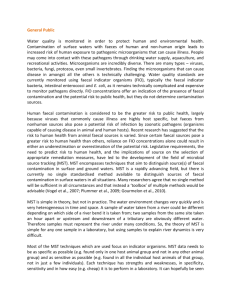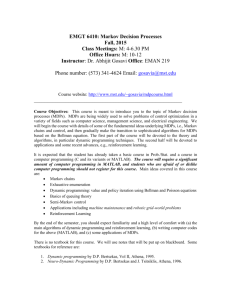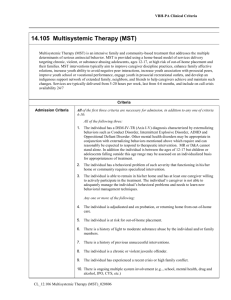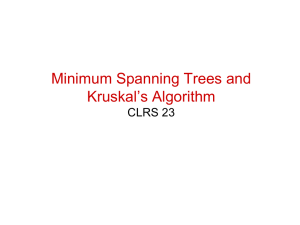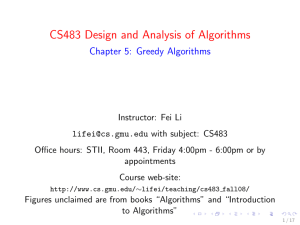Powerpoint slides
advertisement
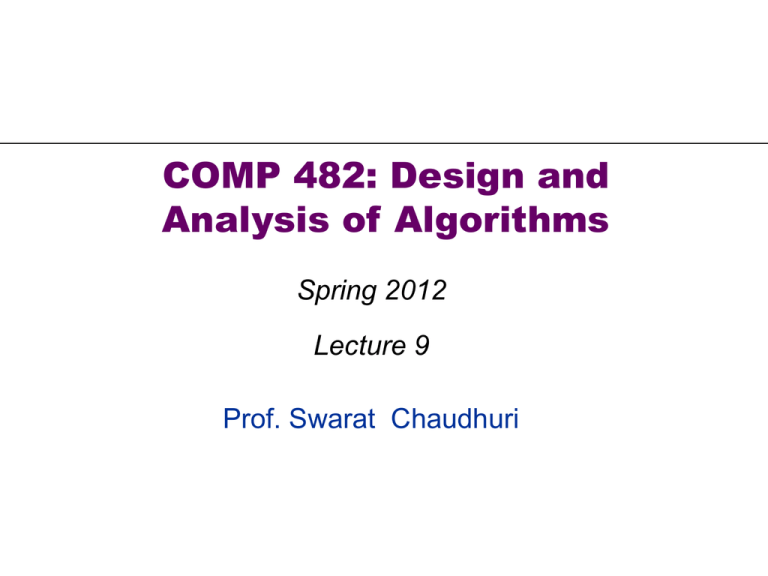
COMP 482: Design and
Analysis of Algorithms
Spring 2012
Lecture 9
Prof. Swarat Chaudhuri
Q1: Fastest travel time
Suppose you have found a travel website that can predict how fast
you’ll be able to travel on a road. More precisely, given an edge e =
(v,w) on a road network, and given a proposed starting time t from
location v, the site returns a value fe(t) that gives you the predicted
arrival time at w. It’s guaranteed that:
1.
fe(t) ≥ t for all edges e;
2.
fe(t) is a monotone function of t.
Otherwise, the functions may be arbitrary.
You want to use this website to determine the fastest way to travel
from a start point to an intended destination. Give an algorithm to
do this using a polynomial number of queries to the website.
2
Answer
Algorithm: r(u) is used to recover the fastest path
S = {s}; d(s) = 0
While S ≠ V
Select a node v not in S with at least one edge from S for which
d’(v) = mine=(u,v): u in S fe(d(u)) is as small as possible
Add v to S and define d(v) = d’(v) and r(v) = u
Proof of correctness: Similar to Dijkstra’s algorithm.
3
Q2: Placing cellphone towers
Consider a long country road with houses scattered sparsely along it.
You want to place cell phone base stations at certain points along
the road, so that every house is within 4 miles of the base station.
Give an efficient algorithm that achieves this goal.
4
Answer
Greedy algorithm:
1.
Start at the western end; keep moving east until there’s a house
exactly 4 miles to the west.
2.
Place a base station at this point.
3.
Delete all the houses covered by this station.
Proof strategy: Greedy stays ahead.
Consider greedy placement S = {s1, …, sk}. Let j be the index at which S
disagrees with every optimal placement. Take an optimal schedule
T = {t1, …, tk} that agrees with S until the index j. Now, sj ≥ tj, as greedy
places sj as far to the east as possible.
But then you can perturb T to get an optimal solution that agrees with
S for one more step.
5
Q3: Membership in MST
Suppose you are given a connected graph G (edge costs are assumed to
be distinct). A particular edge e of G is specified. Give a linear-time
algorithm to decide if e appears in a MST of G.
6
MST properties
Simplifying assumption. All edge costs ce are distinct.
Cut property. Let S be any subset of nodes, and let e be the min cost
edge with exactly one endpoint in S. Then the MST contains e.
Cycle property. Let C be any cycle, and let f be the max cost edge
belonging to C. Then the MST does not contain f.
f
S
C
e
e is in the MST
f is not in the MST
7
Answer
Use the following observation: Edge e = (v,w) belongs to an MST if and
only if v and w cannot be joined by a path exclusively made of edges
cheaper than e.
Proof: () Cycle property.
() Consider the set S of nodes that are reachable from v using edges
cheaper than e. By assumption, w is not in S. Now note that e is the
cheapest edge in the cutset of S. Apply the cut property.
--
This gives us an algorithm: delete from G edge e, as well as all edges
that are more expensive than e. Now check connectivity.
8
Q4: Near-tree
A graph G = (V, E) is a near-tree if it is connected and has at most (n +
8) edges, where n = |V|. Give an algorithm that runs in O(n) time,
has as input a weighted near-tree G, and returns an MST of G. All
edge-costs can be assumed to be distinct.
9
Answer
Apply the cycle property nine times. Perform BFS until you find a cycle
in the graph, then delete the heaviest edge on this cycle. We know
that this edge is not in any MST. Repeat…
10
Q5: Uniqueness of spanning tree
Suppose you are given a connected graph G where edge costs are all
distinct. Prove that G has a UNIQUE minimum spanning tree.
11
Answer
By contradiction. Suppose you have two distinct MSTs T and T’. Then
there is an edge that is in T’ and not in T. Add this edge to T; this
gives you a cycle. Consider the max weight edge in this cycle. This
edge appears in either T or T’, violating the cycle property.
12

